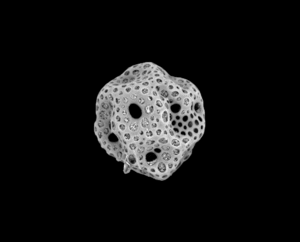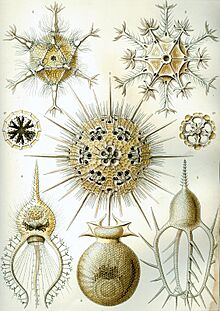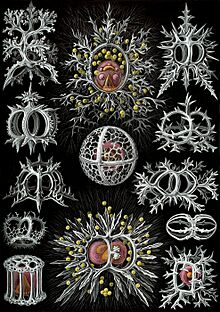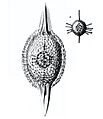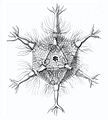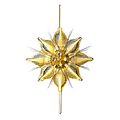Radiolaria facts for kids
Quick facts for kids Radiolaria |
|
|---|---|
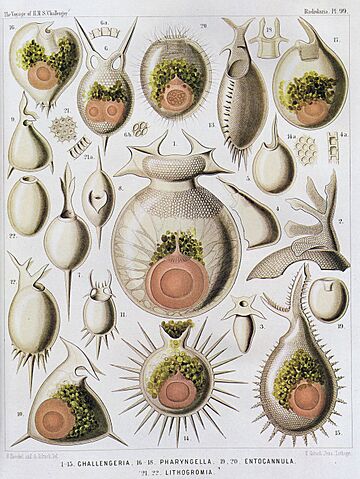 |
|
| An illustration of different Radiolaria from the Challenger expedition (1873–1876). | |
| Scientific classification |
|
| Unrecognized taxon (fix): | Radiolaria |
| Main Groups | |
|
|
Radiolaria (pronounced ray-dee-oh-LAIR-ee-uh) are tiny living things made of just one cell. They are so small, usually only 0.1 to 0.2 millimeters wide, that you would need a microscope to see them. These amazing creatures are famous for building beautiful and complex skeletons, which look like tiny glass sculptures.
They float in the ocean all over the world as a type of zooplankton. While they hunt for even smaller food, many radiolarians also have tiny algae living inside them. These algae use sunlight to make food, which helps feed the radiolarian.
When radiolarians die, their intricate skeletons sink to the bottom of the ocean. Over millions of years, these skeletons can form a thick layer of sediment called siliceous ooze. Because their shapes have changed so much over time, their fossils are very important to scientists for learning about Earth's history.
Contents
What Are Radiolarians?
Radiolarians are single-celled organisms called protists. They have many long, thin arms called pseudopods that stick out from their body. These arms help them float in the water and catch food.
The cell of a radiolarian is divided into two main parts. The inner part, called the endoplasm, holds the nucleus and other important parts of the cell. The outer part, the ectoplasm, is filled with bubbles and droplets that help the creature stay buoyant, like a tiny life vest.
Many radiolarians have a special partnership with algae called zooxanthellae. These algae live inside the radiolarian's cell and use sunlight to make energy through photosynthesis. This provides the radiolarian with most of the food it needs to survive.
Some radiolarians are known for their amazing geometric shapes. For example, the species Circogonia icosahedra has a skeleton shaped like a 20-sided die, called an icosahedron.
Amazing Glass Skeletons
The most famous feature of radiolarians is their skeleton, also called a test. These skeletons are incredibly detailed and come in thousands of different shapes, from spheres with spikes to complex, cage-like structures.
Most radiolarians build their skeletons from silica, the same mineral found in sand and used to make glass. This is why their skeletons look so delicate and glassy. When a radiolarian dies, this hard skeleton can be preserved as a fossil.
However, one group, the acantharians, builds its skeleton from a different material: strontium sulfate. These skeletons are not preserved as fossils because they dissolve in seawater after the organism dies.
Patterns in Nature
The beautiful patterns of radiolarian skeletons have fascinated scientists for a long time. In the mid-20th century, the famous mathematician and computer scientist Alan Turing developed a theory about how patterns, like stripes on a zebra or spots on a leopard, could form in nature.
Later, scientists used computers to test Turing's mathematical ideas. They found that the computer programs could generate patterns that looked almost exactly like the complex skeletons of radiolarians. This showed that simple mathematical rules could explain how these tiny organisms build such amazing and complicated structures.
The German scientist Ernst Haeckel drew thousands of detailed pictures of radiolarians in the 19th century. His drawings showed the world the incredible beauty and variety of these tiny sea creatures.
Clues from the Past
Radiolarians are very old. The first known radiolarian fossils date back to the Cambrian period, over 500 million years ago.
When radiolarians die, their silica skeletons sink to the ocean floor. Over millions of years, these skeletons get buried and become part of the rock layers. Because the types of radiolarians have changed over time, their fossils are very useful to scientists.
These tiny fossils are called microfossils. Scientists who study rocks, called geologists, use radiolarian fossils to figure out the age of rocks. This is very helpful for things like finding oil or understanding what the Earth's climate was like in the distant past.
About 90% of all radiolarian species that have ever lived are now extinct. Studying their fossils gives us a window into the history of life in the oceans.
Images for kids
See also
 In Spanish: Radiolaria para niños
In Spanish: Radiolaria para niños


